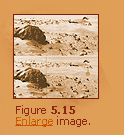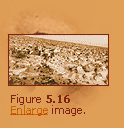|
|

Surface Views
|
Because of the Viking landers, aeolian processes on Mars were
also observed at the surface (Figure 5.15) . The top picture shows
the landing site of Viking I in August, 1976. A year later, a view
of the same area is given at the bottom of the image. Two significant
changes marked by A and B can be recognized. A is a small circular
formation downwind of the Whale Rock. B exposes a new rock surface
near the Big Joe. These were believed to be the result of erosion
of the dust layer at the Martian surface by high winds.
|
 |
 |
 |
 |
Wind deposition on the Martian surface can also occur (Figure
5.16) . This is a view of the landing site of Viking II. Notice
the thin coating of a dust layer mixed with water ice on all the
rocks in this area. These represent the deposition of dust particles
from the atmosphere on the Martian surface. As the Martian atmosphere
changed to a colder winter climate, water and carbon dioxide started
to condense upon dust particles suspended in the atmosphere. The
condensation increased the weight of the dust particles and caused
them to settle onto the ground.
|
The carbon dioxide ice, warmed by the Sun during the day , vaporizes
rapidly, leaving the dust and water ice on the surface for about 100 days
before a warmer climate returned, causing water to vaporize and dust particles
to be blown off the ground and suspended in the atmosphere again for another
cycle of an aeolian process.
< back
1 2
3 4
5
|



